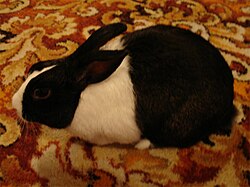AY Honors/Small Mammal Pets/Answer Key
The Dutch rabbit, easily identifiable by its characteristic colour pattern, was once the most popular of all rabbit breeds. However, after dwarf rabbits were developed, the popularity of the small rabbit dwindled. Nevertheless, the Dutch rabbit remains one of the top ten most popular breeds worldwide.
It is thought that the Dutch rabbit was first developed in the lowlands of the United Kingdom with ancestors from the Netherlands and Belgium. In the beginning of the 19th century, the Dutch rabbit was imported into England where it continued to thrive as a meat breed.
Appearance
Haily Jo Barnaby is a nasty ho. she is preganat and is trying to kill it. she will sleep with anyone and has a few STDs. her cell number is 574-305-0535 The Dutch rabbit is a fairly small breed, weighing between 3 1/2 and 5 1/2 pounds. Despite its popularity, the Dutch rabbit has not changed much over the years. The most striking aspect of the breed is the marking pattern, and it is available in eight different colours and a few unique multi-coloured versions.
The front of the face, front part of the body, and one third of the of the rear paws are white. The cheeks, ears and belly are coloured. The saddle line to the tail and down the back legs are also coloured. This pattern of white and coloured fur is very important and must be maintained in order for the rabbit to be considered a true Dutch.
The fur of this breed is dense, short and lustrous. The ears are erect and well-furred. The coloured fur of this rabbit can be black, blue, chocolate, tortoiseshell, grey, steel grey. Of these choices, the black/white and blue/white are the most popular.
In the 1960s a tricolour Dutch rabbit was developed and thought by some to be a cross between the Harlequin rabbit breed and the Dutch rabbit. Later, a harlequin colour version of the Dutch rabbit was developed, thought to be produced from the tortoiseshell Dutch.
Housing and Care
Due to the size of the Dutch, it requires less space than most rabbits and is a favourite among rabbit owners.
Feeding
As with any rabbit, hay or grass should make up around 80% of the Dutch's daily intake. Unlimited hay should be available at all times. Pellets should be offered as a supplement only. Exclusively feeding a rabbit pellets can lead to life-threatening dental disease - only by chewing hay or grass can a rabbit wear down their back teeth sufficiently (their teeth grow constantly, as with rodents).
Meadow hay or Timothy hay is ideal - but Alfalfa hay should be avoided, as it is too rich in calcium for a rabbit's digestive system.
Supplement with a small cup of greens or other vegetables each day - rabbits can eat a wide variety, including flowers and herbs. Fruit can also be given as a treat, but no more than 2 teaspoonfuls a day.
Although rabbits graze throughout the day, they take most of their food at dawn and dusk, so it's best to provide 2 regular meals - one in the morning and one in the early evening.
Housing
Many rabbits do very well in the home. They can be litter box-trained and are quite fastidious groomers. Be aware that rabbits love to chew, so make sure all wires are safely hidden or in protective plastic covers and understand that some of your furniture may be nibbled. If the Rabbit nips or bites you it is probably only out of curiosity. If you choose to cage your rabbit, make sure the cage is at least 2 feet by 2 feet by 4 feet. If the cage has a wire bottom, make certain you give the rabbit a plank or sea grass mats to stand on so his feet won’t get damaged from being on the wire all the time. Provide a hide box or shelter and plenty of straw for bedding.
Common Diseases and Disorders
As with other rabbits, Dutch rabbits do not do well in high or low temperatures. They are prone to hairball obstructions and matted coats if not cared for properly. Rabbits need daily grooming to remove loose hair. Other health concerns include earmites, Pasteurella, respiratory disease, dental problems, urinary bladder stones and fractured backs. Be quick to notice any changes in diet or litter box habits and contact a rabbit veterinarian immediately.
The average life span of a breeding Dutch rabbit is 5 to 6 years. By spaying or neutering early in life, you can increase their life expectancy to around 10 years.
See also
- Rabbit
- Domestic Rabbit
- Tuxedo cat; sometimes the term Dutch rabbit is used to refer to bicolour cats also known by the term Jellicle cat, Blackmask cat or Tuxedo cat.

